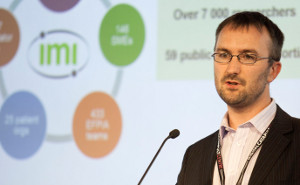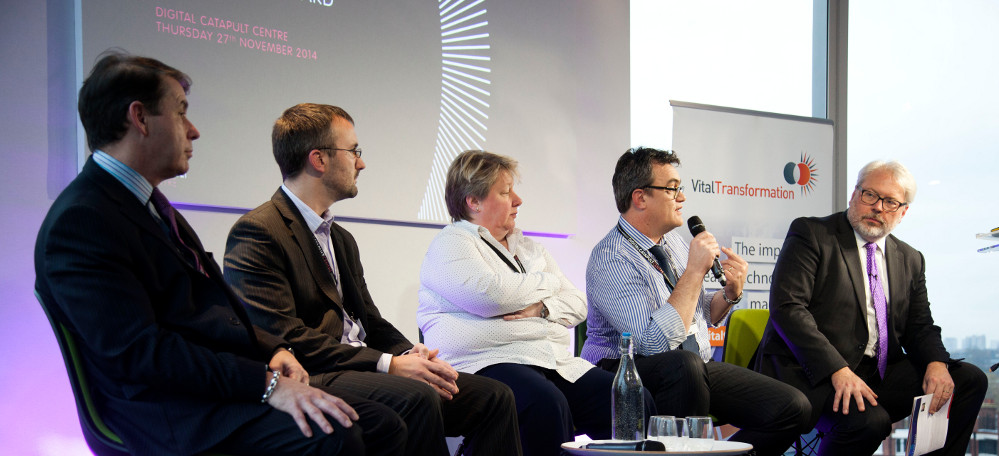Digital Health: Catapulting Personalised Medicine Forward
| AGENDA & SPEAKERS | DOWNLOADS | PICTURES/VIDEOS | CONFERENCE REPORT |
| SESSION 1 | SESSION 2 | SESSION 3 | SESSION 4 |
Session 3: Harnessing public health data to meet medical needs
Painting a “scenario for 2020”, Angus Campbell, Business Development Executive, Healthcare Innovation, IBM, described a “typical middle-aged man in Lycra” exercising to keep healthy and using wearable devices to collect and store data centrally in the cloud.
The question then becomes how to analyse this data dynamically – bearing in mind the man is not (yet) a patient – to make the best, most appropriate use of the information, to create a cumulative view of health status, rather than a series of disparate snapshots.
Such a reporting system could cross reference inputs from wearable devices against other data, for example, symptoms that Lycra Man has reported but which have not led to any treatment. “In other words you could build a provisional diagnosis based on multiple sources from the electronic health record, family history and live inputs from the device,” Campbell said.
A clinician could then review the diagnosis and feed this personalised information back to Lycra Man via an app over the cloud.
“I said 2020, but in fact you can do all this now,” Campbell concluded.
The fact that the development of stratified and personalised medicines will require the pharma industry to collaborate with technology companies is acknowledged in the Innovative Medicines Initiative 2, a €3.4 billion programme of research to enhance drug discovery and development, running from 2014 – 2020, with joint funding from pharma and the European Union.
The €2 billion forerunner, IMI 1 involved the industry working in collaboration with academic partners and biotech SMEs. “Now IMI 2 is not just pharma; it is reaching out to other industries. The problems we are facing in healthcare are wider than pharma,” said Colm Carroll, Scientific Project Manager, IMI.
A notable example of the power of pooling resources in IMI is the European Medical Information Framework, which is developing a common information framework of patient-level data, linking up and facilitating access to diverse medical and research data sources.
Companies joining the IMI research effort can either contribute ‘in kind resources’ and make inputs to define projects, or they can respond to calls and join as beneficiaries of grants.
Upcoming digital health projects include RADAR (Remote Assessment of Disease and Relapse) in central nervous system disorders; assessing risk and progression in prediabetes and Type II diabetes; and the development of an enabling platform for Medicines Adaptive Pathways to Patients.
RADAR will use biosensors to develop biosignatures that characterise a disease and can be used to predict changes in disease state. The programme aims to understand and map the regulatory pathway for using such remote assessments in healthcare, develop standards for exchanging information and consider how remote sensing can be factored into clinical study design, Carroll said.
Cancer Research UK (CRUK) has taken a lead role over the past five years in the drive to develop stratified medicines in the UK. As Monica Jones, Enterprise Architect at CRUK, who has spearheaded the project told delegates, CRUK saw mutation testing was happening, but that there was no funding to apply the results to improve treatment.
The charity decided to invest in the area and pulled in other research funders and pharma companies behind this effort.
One of the best known examples of stratification in current practice is testing for the presence of epidermal growth factor receptor (EGFR) mutations, allowing patients with the mutation to received targeted treatment with EGFR-tyrosine kinase inhibitors This not only avoids wasting drug resources on patients who will not respond: it turns out that if patients who do not have the EGFR mutation are treated with targeted drugs they do less well than patients who receive standard of care, Jones noted.
The aim of the work carried out by CRUK and its partners is to establish principles that could underpin a national roll-out of stratified cancer treatment, considering these factors:
- The retrieval and integration of NHS records
- Maintaining secure databases
- Allocating controlled access to validated members of the research community for meta-analysis.
The Stratified Medicines Initiative is built around existing genetic testing services. Having set up the framework, the programme met its target of accruing 9,000 patients in two years. Based on this success, the project proceeded directly to Stratified Medicines 2. “We are getting into really detailed analyses. There have been benefits: there are patients who are surviving now, who wouldn’t have done without stratified medicine,” Jones concluded.
To date the Clinical Practice Research Datalink (CPRD) has provided research and services for third parties to carry out observational studies on its primary care database. Now it is expanding and shaping its resources for the needs of observational studies, as Tim Williams, Head of Research at CPRD told the meeting.
One example of the new services that will be available is a metadata framework to help people realise the potential of this anonymised repository. “Using primary care databases is extremely complicated; one of the biggest challenges is to understand how to use this patient data,” Williams said.
CPRD is also developing TrialViz, a tool to enable clinical trial sponsors to find out if there are enough subjects meeting inclusion criteria. Following protocol optimisation, CPRD can identify patients and through a trusted third party broker, contact their GPs and invite them to take part in studies.
A data exchange gateway and interfaces to thirty party computer systems will allow external developers to write applications that draw on CPRD data. CPRD also plans to collaborate with other bodies working on big data in healthcare, for example, the Farr Institute of Health Informatics Research, to train more bioinformaticians. (The Farr Institute carries out research linking electronic health data to other types of research data).
| SESSION 1 | SESSION 2 | SESSION 3 | SESSION 4 |
This event was organised in collaboration with:
 |
 |
 |




